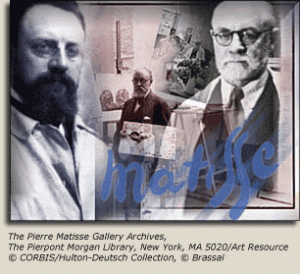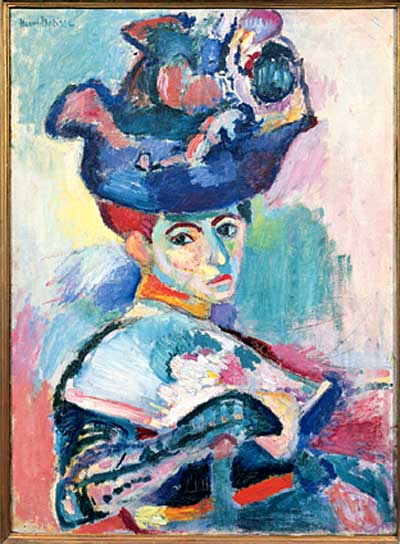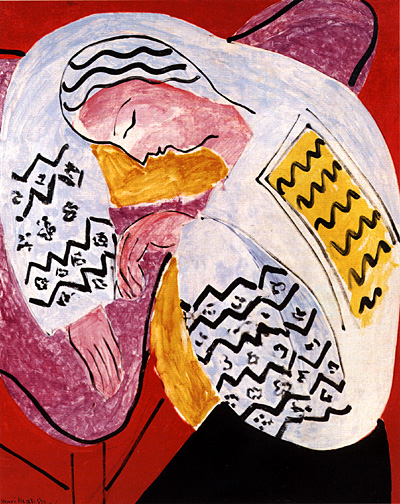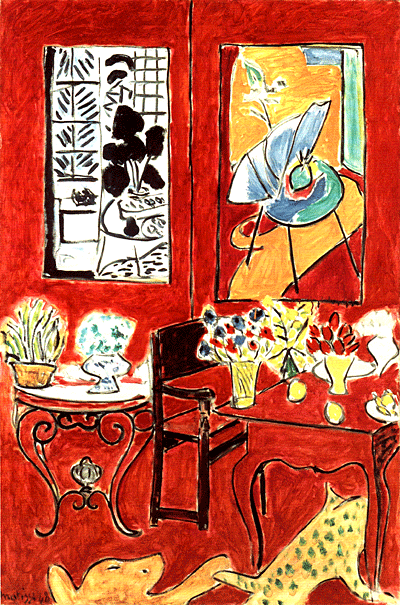History recalls Henri Matisse as one of the giants of twentieth-century art. Readily identified with the fauvist (wild beasts) art style and later with paper cut-outs, Matisse continued experiments with color and line throughout his art career. Pablo Picasso, in a rare acquiescence to the abilities of another artist, considered Matisse an artistic equal. A variety of artworks by both artists recall or reflect the work of the other.
 Born in Northern France in 1869 to a grain merchant father and a mother who was described as “artistically inclined” (she painted china and made hats), Henri Emile Benoit Matisse received little early encouragement to become an artist. At the age of 18 he was enrolled at the Faculty of Law in Paris, soon passed his law exams, and took a job as a law office clerk.
Born in Northern France in 1869 to a grain merchant father and a mother who was described as “artistically inclined” (she painted china and made hats), Henri Emile Benoit Matisse received little early encouragement to become an artist. At the age of 18 he was enrolled at the Faculty of Law in Paris, soon passed his law exams, and took a job as a law office clerk.
It was only after Matisse suffered appendicitis and was confined to bed for almost a year that he was afforded an opportunity to explore his artistic bent. Hoping to provide her recuperating son with activities to fill his empty hours, Matisse’s mother bought art supplies for him. Matisse began to copy paintings, and then later (after he was recovered from his illness), he took drawing lessons while continuing to work in the law office. Soon, Matisse abandoned law in favor of art. At the age of 22, he again traveled to Paris, but this time it was to study painting. Paris was rich in the arts, and Matisse availed himself of the many museums there, often copying masterworks in the galleries. By 1896, Matisse was successfully exhibiting his paintings in Paris. Within a decade, Matisse was the recognized leader of the art style known as fauvism — a style characterized by its unusual use of bold and often illogical colors. It was during this period when Matisse met Picasso for the first time. Although the initial meeting was not especially cordial, a relationship of mutual respect and professional exchange later developed.
In 1917, Matisse left Paris to work in the quiet atmosphere of Southern France. About a decade later, Matisse’s career lost momentum. Called a “has been” by art critics, Matisse could find little inspiration for creating art. Perhaps it was Picasso’s parodies of Matisse’s motifs that brought him out of his artistic slump. Indeed, comparing the two artist’s works during this time finds many similarities — a sort of visual conversation — suggesting that each interpreted similar subjects in their own styles. One such example is Matisse’s 1940 painting, The Dream, undeniably a reference to Picasso’s 1931 painting, Woman with Yellow Hair. Similar to the way his career began, a serious illness followed by surgery threatened to stop Matisse’s work. As a result of his illness, from 1941 until his death Matisse was often forced to work from his bed or from a wheelchair. Undeterred by overwhelming odds and spurred by Picasso to continue, Matisse triumphed with a variety of recognized masterworks including Large Red Interior, 1948.
Matisse died November 3, 1954 in Nice, France.
“Expression, for me, does not reside in passions glowing in a human face or manifested by violent movement. The entire arrangement of my picture is expressive; the place occupied by the figures, the empty spaces around them, the proportions, everything has its share.”
– Henri Matisse, 1908, Notes of a Painter
Paintings

WOMAN WITH HAT (MADAME MATISSE), Henri Matisse, 1905 (© 2001 Succession H. Matisse, Paris/Artists Rights Society (ARS), New York)
Woman with Hat, 1905, approximately 31-3/4” x 23-1/2”, is an abstracted portrait of Matisse’s wife. The painting exemplifies the fundamental characteristics of fauvism with its choice of subject (a portrait), energetic paint strokes, and use of unnatural colors. Madame Matisse’s dress, skin, and feathered hat — as well as the background — are all portrayed with unrealistic shades of vivid colors applied with active brushwork. When Woman with Hat was first exhibited, critics gave overwhelmingly unfavorable reviews. Few critics of the time could comprehend why Matisse would chose to paint his wife’s portrait with blotches of unrealistic and garish colors. Today, Woman with Hat is a recognized masterpiece that helped to define fauvism, but more importantly, helped to set the course of modern art.

THE DREAM OF 1940, Henri Matisse, Jan.-Oct. 4, 1940 (© 2001 Succession H. Matisse, Paris/Artists Rights Society (ARS), New York)
The Dream, 1940, approximately 31-7/8” x 25-5/8”, uses characteristics common in many of Matisse’s paintings: a female model depicted with sensual line qualities and rich color. In this painting, a sleeping figure rests her head on her right arm, her body gracefully dividing the picture plane into areas of floating color and overlapping shapes. A rich Venetian red defines the perimeter of the painting, contrasting with the white of the sleeper’s blouse and the ink black of her skirt. The line and color of the painting add to its general decorative effect. The Dream readily compares to Picasso’s Woman with Yellow Hair, painted in 1931.

LARGE RED INTERIOR, Henri Matisse, 1948 (© Succession H. Matisse, Paris/Artists Rights Society (ARS), New York)
Large Red Interior, 1948, approximately 57-1/2” x 38-1/4”, is the last major painting that Matisse attempted. It is included in the series known as the Vence Interiors, a period when Matisse created some of his greatest works of art. In this artwork, Matisse brings to fruition his fascination with color and line. Literally inundated in Venetian red, the objects that populate Large Red Interior seem to be free from the constraints of gravity. The lines that define the objects (and the interior itself) have no visible vanishing points. In what the viewer might see as the near background, Matisse has included a window open to the outside world and a version of his own painting, The Pineapple, painted earlier in 1948.
Timeline
1869: Born, December 31, Cateau-Cambrésis, France
1887-1889: Studies law in Paris; returns home and works as a clerk in a law firm
1890: Suffers appendicitis; during year-long recovery begins to draw and paint
1900: Moves to Paris; enrolls in art school
1905-1906: Paints The Woman with the Hat and Le Bonheur de Vivre (Joy of Life); meets Picasso
1917: Moves to Nice, in Southern France
1918: Exhibits with Picasso at the Paul Guillaume Gallery, Paris
Late 1920s: Critics proclaim Matisse a “has-been;” Matisse suffers “inspirational crisis” and has difficulty creating artworks
1930s: Matisse makes a triumphant return to painting
1939-1945: World War II in progress; modern art proclaimed degenerate; paints The Dream, a direct reference to Picasso’s Woman with Yellow Hair; remains in Southern France throughout war
1941: Suffers intestinal infection; subsequent years spent working mostly from bed or wheelchair
From 1946: Participates with Picasso in public events, meets in private with Picasso, exchanges artwork
1948: Paints Large Red Interior, his last major canvas
1954: Dies in Nice, France

